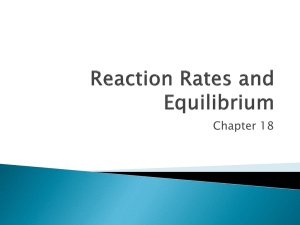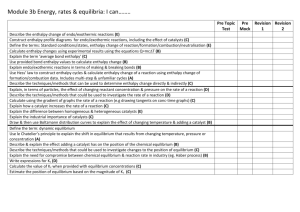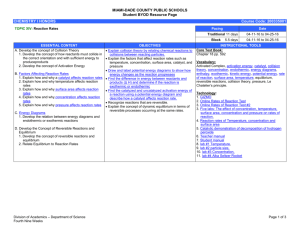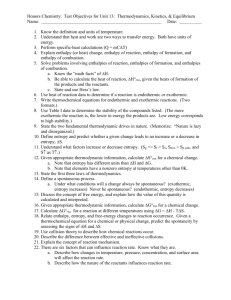reverse reactions
advertisement
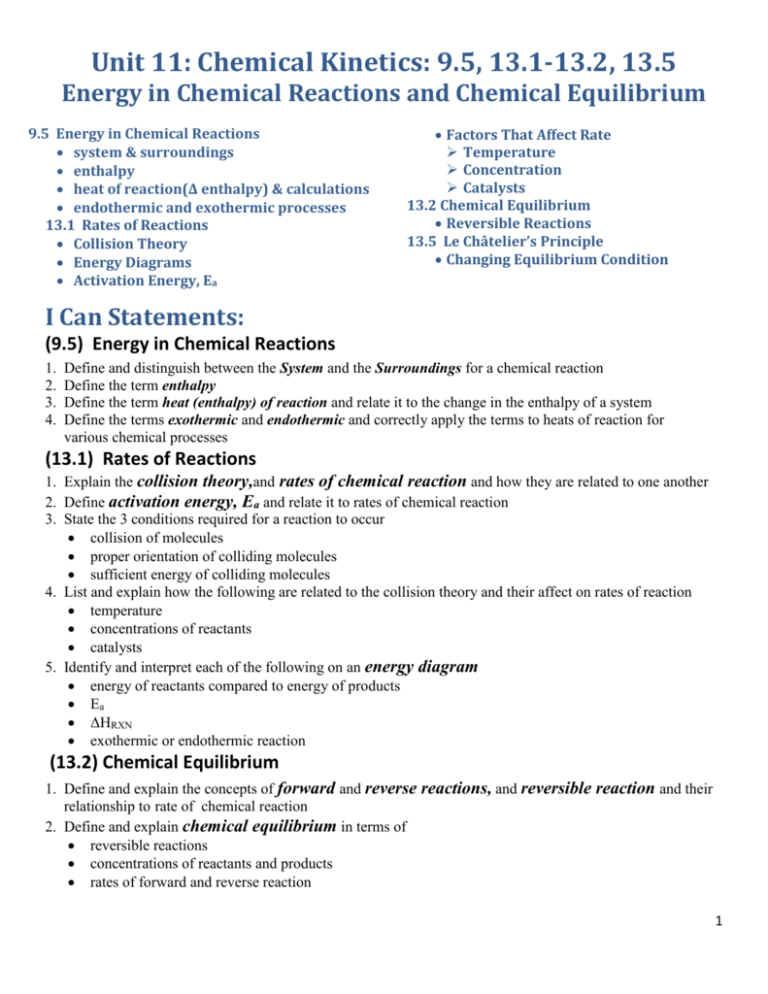
Unit 11: Chemical Kinetics: 9.5, 13.1-13.2, 13.5 Energy in Chemical Reactions and Chemical Equilibrium 9.5 Energy in Chemical Reactions system & surroundings enthalpy heat of reaction(Δ enthalpy) & calculations endothermic and exothermic processes 13.1 Rates of Reactions Collision Theory Energy Diagrams Activation Energy, Ea Factors That Affect Rate Temperature Concentration Catalysts 13.2 Chemical Equilibrium Reversible Reactions 13.5 Le Châtelier’s Principle Changing Equilibrium Condition I Can Statements: (9.5) Energy in Chemical Reactions 1. 2. 3. 4. Define and distinguish between the System and the Surroundings for a chemical reaction Define the term enthalpy Define the term heat (enthalpy) of reaction and relate it to the change in the enthalpy of a system Define the terms exothermic and endothermic and correctly apply the terms to heats of reaction for various chemical processes (13.1) Rates of Reactions 1. Explain the collision theory,and rates of chemical reaction and how they are related to one another 2. Define activation energy, Ea and relate it to rates of chemical reaction 3. State the 3 conditions required for a reaction to occur collision of molecules proper orientation of colliding molecules sufficient energy of colliding molecules 4. List and explain how the following are related to the collision theory and their affect on rates of reaction temperature concentrations of reactants catalysts 5. Identify and interpret each of the following on an energy diagram energy of reactants compared to energy of products Ea ΔHRXN exothermic or endothermic reaction (13.2) Chemical Equilibrium 1. Define and explain the concepts of forward and reverse reactions, and reversible reaction and their relationship to rate of chemical reaction 2. Define and explain chemical equilibrium in terms of reversible reactions concentrations of reactants and products rates of forward and reverse reaction 1 (13.5) Le Châtelier’s Principle 1. State and explain Le Châtelier’s Principle 2. Explain and predict the effect of each of the following on chemical equilibrium concentration changes volume and pressure changes catalysts temperature changes Vocabulary 9.5, 13.1-13.2, 13.5 Activation Energy Catalyst Chemical Equilibrium Collision Theory Enthalpy Endothermic Exothermic Forward Reaction Heat (Enthalpy) of Reaction Le Châtelier’s Principle Rate of Reaction Reverse Reaction Reversible Reaction System Surrounding Achievement Scale 13.1-13.2, 13.5 Goal B Level A Level 9.5 Energy in Chemical Reactions Can define and distinguish between system and surroundings for a chemical reaction Can define and relate the terms enthalpy and heat of reaction Can define and correctly apply the terms exothermic and endothermic to the heats of reaction for various chemical processes C Level Can calculate the enthalpy change for a chemical reaction and state if that change for was exothermic or endothermic based on the mathematical sign Given a chemical reaction with its molar enthalpy value, can use stoichiometry to convert between enthalpy and amount. 13.1 Rates of Reaction Can define the collision theory of chemical reactions Can define the rate of a chemical reaction Can define activation energy Can state the 3 requirements for a reaction to occur Can identify and Can explain the interpret the information effects of contained in an energy temperature, diagram concentration, and catalysts on Can explain how the the rate of collision theory can be chemical reaction used to explain rates of chemical reactions Can explain chemical equilibrium in terms of reversible reactions, concentrations of reactants and products, and rates of forward and reverse reaction Can predict the effect of Given a chemical concentration changes, equilibrium, can catalysts, volume and manipulate the pressure changes, and necessary temperature changes on variables to chemical equilibrium achieve a stated outcome. 13.2 Can define and explain the concepts of a Chemical forward and reverse reactions and Equilibrium reversible reactions and their relationship to rates of chemical reaction Can define chemical equilibrium 13.5 Le Châtelier’s Principle Can state Le Châteliers Principle List what variables will change the equilibrium of a reaction. 2 Sample Questions 9.5, 13.1-13.2, 13.5 C Level: 1. When the following reaction is performed the temperature increases dramatically - in other words, heat is actually one of the products of this reaction. CH4 (g) + 2 O2(g) → CO2 (g) + 2 H2O (l) + heat(energy) ΔERXN = − 890 kJ/ mol Explain the meaning ΔERXN = − 890 kJ/ mol in terms of bonding and energy changes for the reaction. 2. What is the name of the theory that states that reactions will only take place when the reacting molecules collide with the proper energy and orientation? 3. How do catalysts affect the rate of chemical reaction? 4. (a) Identify what is represented by each of the letters on the following Energy Diagram. (b) Was this reaction exothermic or endothermic? Justify your answer. 3 5. List 3 things that influence the rate of a chemical reaction. 6. State how each of the following would change the rate of the following reaction. Justify your answer in each case. 2 NO(g) + 2 H2 (g) → N2(g) + 2 H2O(g) Rate Justification (a) Some NO (g) is taken away. (b) The temperature is decreased. (c) Some H2(g) is added. (d) A catalyst is added. 7. What is a reversible reaction? 8. Write both the forward and reverse reaction for the following reversible reaction. N2(g) + 3 H2(g) 2 NH3(g) 9. Define chemical equilibrium in terms of: (a) concentration of reactants and products (b) rate of reaction 4 9. State whether the following statement is TRUE or FALSE. Justify your answer. At equilibrium the concentrations of reactants and products are equal to each other. 10. State Le Châtelier’s Principle. 11. Ammonia is produced by reacting nitrogen gas and hydrogen gas. N2(g) + 3 H2(g) 2 NH3(g) + 92 kJ For each of the following changes at equilibrium, indicate whether the equilibrium shifts towards product or reactant or does not shift: EQULIBRIUM SHIFT (a) removing N2(g) (b) adding NH3(g) (c) lowering the temperature (d) adding H2(g) (e) increasing the volume of the container 5

